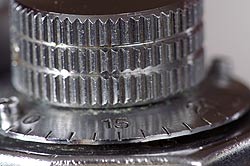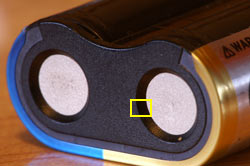Konica Minolta AF 200mm f/4 Macro APO
At the top end of the true Macro range are a group of lenses around the 200mm mark. Giving a good working distance from the lens, we take a look at this offering from Konica Minolta.
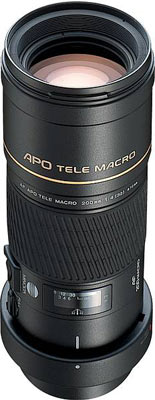 Specifications
Specifications
- Focal Length 200mm
- Max aperture f/4
- Min aperture f/32
- Min focus distance 0.5m
- Elements/groups N/A
- Ratio 1:1
- Dimensions 79x195mm
- Weight 1.13kg
- Tripod bush Yes (supplied)
- Mount Minolta A type bayonet
- Price(RRP) 1429.99
Build and Handling
This lens is a solid and well-built professional offering that comes with a fitted tripod mount collar. This has spot marks on it to denote portrait and landscape orientations with a line on the lens as a guide mark. This was a little annoying, as you have to turn your head to the side to see the marks for portrait mode. I would sooner have seen the marks on the lens and a guide on the collar!
On the left, forward of this, is a turn switch that acts as a focus limiter. It operates each side of the 0.75m mark to improve AF speed or can be switched off for the full focus range. In front of this is a button that locks the AF setting while held to stop the camera re-focussing. Central on the barrel is a distance window marked in metres and feet, with the addition of a third scale indicating the magnification ratio on the sensor/film.
Next up comes a wide (40mm), neatly ribbed manual focus ring that is fixed during AF and cannot over-ride the AF. Once switched to MF, achieved on the camera with the Minolta system, it is nicely torqued but takes a full turn to achieve the full range. There is another 70mm of lens in front of this prior to the hood bayonet mount and the 72mm filter thread. Autofocus performance is slow, as is common with Macro lenses and it is accompanied by some noise, although this is not deafening! All of the focussing is carried out internally, so the length remains constant and the front end does not rotate, making filter use easy.
Optical Quality
Once again with a K-M lens, the optical performance across the aperture range was highly consistent and only the edge performance wide open let it down fractionally. There is, effectively, no distortion with a measured figure of 0.07% from the Imatest distortion module.
Chromatic aberration also, across the entire range, produced exceptionally low figures showing that the lens is well corrected for this annoying phenomenon. Resolution and contrast combine to produce sharp looking images with a pleasing colour balance.
|
|
| 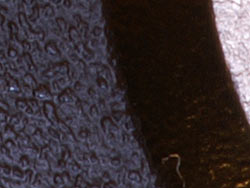 This 100% crop of the area marked shows the detail that can be picked out at these magnifications. The surface of the battery looks smooth to the naked eye. All pictures taken on a Dynax 5D |
Click on each comparision photo below to view full size versions
Below is our lens test data. To find out how to use these graphs look at this article: How we test lenses
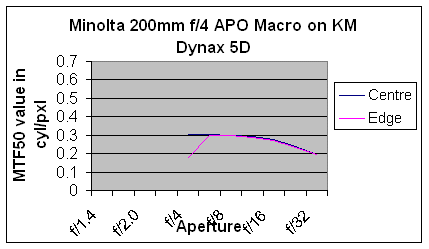
Verdict
A top quality, long Macro lens that is obviously built to last and has an optical quality that goes a long way towards warranting its price. However, there are one or two handling niggles that spoil an otherwise superb lens. The focus limiter switch requires removing your hand from the lens and using thumb and forefinger to adjust, where a slide switch could be operated with the thumb alone without removing your hand. The tripod collar is the other.
In summary, the positive points of the KM APO 200mm f/4 (G) Macro are:
![]() Superb optical quality
Superb optical quality
![]() Excellent build quality
Excellent build quality
The negative points are:
![]() Niggly handling points
Niggly handling points
![]() Price
Price
Check the latest price of the K-M APO 200mm f/4 (G) Macro here
Test by Ian Andrews www.wildaboutkent.co.uk
I personally have not found the focus to bee too slow, especially when using the focus limiter. Manual focusing is very good - you have to accept large focsing ring turn in macro lens due to accurate focusing.
Images prouduced with this lens are sharp, contrasty and colours are natural. I compared it with Sigma 70-200/2,8 APO before buying and K-M was better in my not-so-scientific test of street photos (I tend to test lenses outside in bright light by taking photos of contrasty non-flat objects like buildings. This eliminates testing problems like incorrect focus and possible field curvature).
As with all internal focusing macros, the true focal lengt at the closest focusing distance is not 200 mm but 125 mm. However, this is comparable with other long macros (they all probably use internal focusing, only 50 mm macros tend to use extension focusing and maintain the focal length).
The lens is HEAVY, but then the price per kg gets lower... You have to use tripod in macro. Build is very good.
Sony has now (sadly) discontinued this lens, so there probably are not many available on the market. I found mine as new in the local shop, and paid reasonable price - althoug this was also quite a lot.
I am looking at both MTF charts and see the Nikon to be 33% sharper MTF center value 0.4 vs 0.3 for this lens. On the Nikon the edge sharpness is equal to the Minolta lens here but the at F8 or above it as good as the center. The center sharpness on the Minolta lens is only 0.3 so I guess the edge sharpness is not noticebly lower.
Now how does this lens get the outstanding optical rating vs adequate optical performance for the Nikon under the Optical Quality heading, am I missing someting?
So, Apollo, you're probably missing something ;-) but I agree with you about different meters used through this site. Perhaps, too many reviewers are writing without adequate coordination?
I've found much more interesting MTF tests (film-based), which haven't been available during last years on this site. It's a shame that newer lenses will not be tested with this older (more scientific and accurate) standard.
Add your message
Please login here or if you've not registered, you can register here. Registering is safe, quick and free.
photodo Stats
428 MTF tests
74 in-depth photodo reviews
100+ users join each day
Help the lens community by reviewing or rating a lens today via our lens search
Latest Lens Reviews
- Chinon 28mm f/2.8 Vintage Lens Review
- Canon EF 70-200mm f/4L IS II USM Lens Review
- Samyang AF 85mm f/1.4 EF Review
- Sigma 70mm f/2.8 DG Macro Art Review
- Samyang AF 24mm f/2.8 FE Review
- Meike 50mm f/1.7 Review
- Tamron 70-210mm f/4 Di VC USD Review
- Lensbaby Burnside 35mm f/2.8 Review
- Asahi Super Takumar 50mm f/1.4 Review
- Asahi Super-Multi-Coated Takumar 135mm f/3.5 Review
